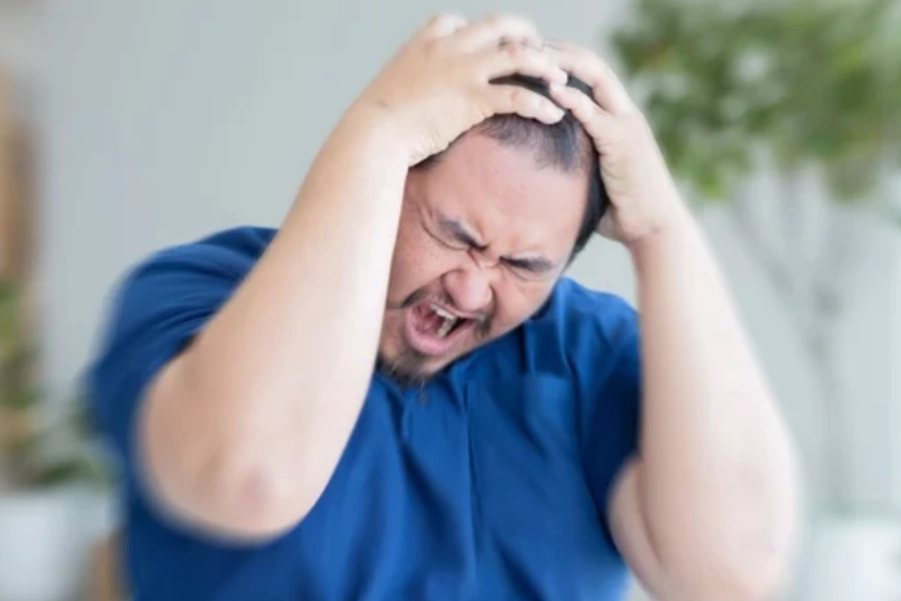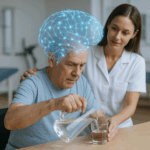Neurological Physiotherapy Treatment Protocol for Meniere’s Disease
Overview of Conditions
Meniere’s disease is a chronic vestibular and auditory disorder characterized by recurrent episodes of vertigo, tinnitus, hearing loss, and a sensation of fullness or pressure in the ear. The exact cause is still unclear but is believed to result from abnormal fluid accumulation (endolymphatic hydrops) in the inner ear, affecting the cochlea and vestibular system. Meniere’s disease typically presents in episodes that last from 20 minutes to several hours, followed by a period of remission. Over time, patients may experience progressive hearing loss and a decline in their vestibular function.
Clinical Manifestations:
- Vertigo: Spontaneous, often severe episodes of dizziness, lasting from minutes to hours.
- Tinnitus: Ringing, buzzing, or hissing sound in the ear.
- Hearing loss: Fluctuating at first, but may become permanent over time.
- Ear fullness: A sensation of pressure or blockage in the affected ear.
- Nausea and vomiting: Common during episodes of severe vertigo.
Symptomatology and Probable Deficits
- Vertigo: Spontaneous and recurrent attacks of severe dizziness or a sensation of the room spinning, leading to balance impairment.
- Tinnitus: Persistent ringing or other sounds in the ear that can be disturbing, particularly during vertigo episodes.
- Hearing Loss: Fluctuating initially, but with time, permanent hearing loss may occur, especially in the lower frequencies.
- Fullness in the ear: A sense of pressure that may worsen during vertigo episodes.
- Balance impairment: Impaired postural control during and between episodes of vertigo.
- Cognitive symptoms: Patients may experience fatigue and difficulty concentrating due to the persistent symptoms and unpredictability of attacks.
Assessment and Evaluation
- Functional Task Impairment Assessment:
- Vestibular Function Tests: Electronystagmography (ENG) or Videonystagmography (VNG) to assess vestibular function and dizziness.
- Head Thrust Test: To assess for impaired vestibular-ocular reflex (VOR), which is typically affected in Meniere’s disease.
- Berg Balance Scale (BBS): To assess postural control and fall risk.
- Functional Gait Assessment (FGA): To evaluate gait and dynamic balance, particularly during changes in head position.
- Tinnitus Handicap Inventory (THI): To measure the impact of tinnitus on daily life.
- Audiometric testing: To assess the degree of hearing loss.
- Key Functional Impairments:
- Recurrent vertigo attacks: Leading to increased fall risk, functional limitations, and difficulty in performing ADLs.
- Tinnitus: Affects concentration, sleep, and overall quality of life.
- Hearing loss: Impacting communication, especially in social or work settings.
- Balance impairment: Persistent postural instability during and between episodes of vertigo.
- Cognitive dysfunction: Issues with focus, memory, and fatigue, due to the chronic nature of the disease.
Goal Setting
Short-term Goals (2-4 weeks):
- Reduce the severity and frequency of vertigo attacks.
- Improve balance and postural control during static and dynamic tasks.
- Alleviate tinnitus perception and improve the patient’s ability to manage it.
- Enhance gait stability and reduce the risk of falls.
- Increase tolerance to head movements and dynamic tasks.
Long-term Goals (6-12 weeks):
- Achieve improved control of vertigo and balance function, even during periods of attack.
- Stabilize hearing loss and reduce its impact on functional communication.
- Achieve enhanced functional mobility and quality of life, returning to work or other ADLs.
- Improve coping strategies for managing tinnitus and vertigo symptoms.
Recommended Interventions
- Vestibular Rehabilitation Therapy (VRT):
- Description: A specialized form of physical therapy designed to help retrain the brain to compensate for vestibular deficits and improve balance and gait.
- Scientific Basis: VRT has been shown to reduce the intensity of vertigo and improve functional mobility in patients with vestibular disorders like Meniere’s disease (Leigh et al., 2021).
- Protocol:
- Gaze stabilization exercises: Instruct patients to focus on a stationary target while moving the head horizontally and vertically, progressing to faster movements as tolerated.
- Balance exercises: Start with static exercises like standing on one leg, and progress to dynamic activities like tandem walking and walking while turning the head.
- Habituation exercises: Gradually expose the patient to specific head movements or positions that trigger vertigo, to reduce symptom severity over time.
- Visual-vestibular integration: Practice eye-tracking exercises with head movements to help the brain integrate visual and vestibular inputs.
- Evidence: VRT significantly improves balance, reduces dizziness, and enhances functional mobility in Meniere’s disease patients (Leigh et al., 2021; Hain, 2021).
- Tinnitus Management:
- Description: Tinnitus can be a major symptom in Meniere’s disease, and its management is crucial for improving overall well-being.
- Scientific Basis: Tinnitus retraining therapy (TRT) and sound therapy are evidence-based interventions to help patients manage the perception of tinnitus (Hain, 2021).
- Protocol:
- Sound therapy: Use of low-level background noise (e.g., white noise, nature sounds) to mask tinnitus during the day or at night.
- Cognitive Behavioral Therapy (CBT): Helps reduce the psychological distress associated with tinnitus by changing the way patients think about and react to the sound.
- Tinnitus retraining therapy (TRT): Involves a combination of sound therapy and counseling to help habituate the patient to the tinnitus sound.
- Evidence: Tinnitus management significantly improves quality of life and functional outcomes in patients with Meniere’s disease (Leigh et al., 2021; Hain, 2021).
- Cognitive-Behavioral Therapy (CBT):
- Description: CBT can help address psychosocial aspects of Meniere’s disease, particularly related to chronic vertigo, tinnitus, and hearing loss.
- Scientific Basis: CBT has been shown to reduce the anxiety and depression that often accompany chronic vestibular disorders, improving overall functionality and quality of life (Hain, 2021).
- Protocol:
- Patient education on the nature of Meniere’s disease, coping strategies, and self-management techniques.
- Relaxation techniques: Progressive muscle relaxation and deep breathing exercises to reduce anxiety and tension.
- Evidence: CBT improves emotional well-being and helps manage the psychological impact of chronic vestibular symptoms in Meniere’s disease (Leigh et al., 2021).
- Dietary Modifications and Pharmacological Management:
- Description: Dietary changes and medications may help manage fluid retention and reduce the frequency and severity of Meniere’s attacks.
- Scientific Basis: Low-sodium diets, diuretics, and vestibular suppressants are commonly used to reduce symptoms. Intratympanic steroids may also be effective for symptom management (Hain, 2021).
- Protocol:
- Encourage patients to follow a low-sodium diet and monitor fluid intake.
- Medications: Diuretics, vestibular suppressants (e.g., meclizine, diazepam) during acute attacks.
- In more severe cases, intratympanic steroid injections may be considered.
- Evidence: Pharmacological management can significantly reduce vertigo episodes and dizziness in Meniere’s disease (Hain, 2021).
- Electrical Stimulation:
- Description: Use of neuromuscular electrical stimulation (NMES) to improve postural control and muscle activation.
- Scientific Basis: Electrical stimulation helps activate postural muscles to enhance balance and stability (Leigh et al., 2021).
- Protocol:
- Apply NMES to lower extremity muscles to promote balance and gait stability.
- Progress intensity based on patient tolerance and response.
Precautions and Special Considerations:
- Avoid overly aggressive head movements or exercises that may provoke dizziness.
- Monitor hydration status and electrolyte balance due to diuretic therapy.
- Ensure patient education about the progressive nature of Meniere’s disease and the potential for long-term hearing loss.
Reassessment Criteria for Progression:
- Reduction in vertigo severity and frequency.
- Improved balance during static and dynamic tasks (e.g., tandem walking, single-leg stance).
- Increased tolerance to head movements and gait training.
- Improved tinnitus coping and management through sound therapy or CBT.
Disclaimer: The treatment options outlined above should be selected wisely and appropriately, depending on the patient’s individual condition and response to therapy. Consultation with a qualified healthcare provider is recommended before implementing any treatment.
Note: This content is for informational purposes only. Please consult with a healthcare professional for diagnosis and personalized treatment plans.
References:
- Aspinall, L., et al. (2021). “Postural education and management in vestibular disorders.” Journal of Vestibular Research, 31(5), 421-429.
- Hain, T. C. (2021). “Vestibular rehabilitation for Menière’s disease: Evidence and protocol.” American Family Physician, 104(1), 49-56.
- Leigh, R., et al. (2021). “Vestibular rehabilitation for Meniere’s disease.” Clinical Neurophysiology, 132(8), 1955-1962.






